
11 Buildings on Alcatraz Island: History and What To See Now
When you think about Alcatraz, sitting in the middle of the San Francisco Bay, you probably think about the iconic prison that housed some of the country’s most notorious prisoners. It stands out in every postcard, situated on top of a hill on this tiny 22-acre island.
But Alcatraz has many more buildings besides the cellhouse where prisoners lived. Some are accessible to the public. Others are in ruins, making for some atmospheric photos. In recent years, park officials have also restored several historic Alcatraz buildings, many of which have been damaged by salt air corrosion.
The buildings and other structures that stand today reflect the island’s history and its many lives as a fortress, military prison, federal penitentiary, protest site and a national park. You can learn more fascinating bits of Alcatraz’s storied past by visiting these dozen or so structures and ruins.
Here’s the complete list of the historic buildings you can see today on Alcatraz Island.
1. Cellhouse
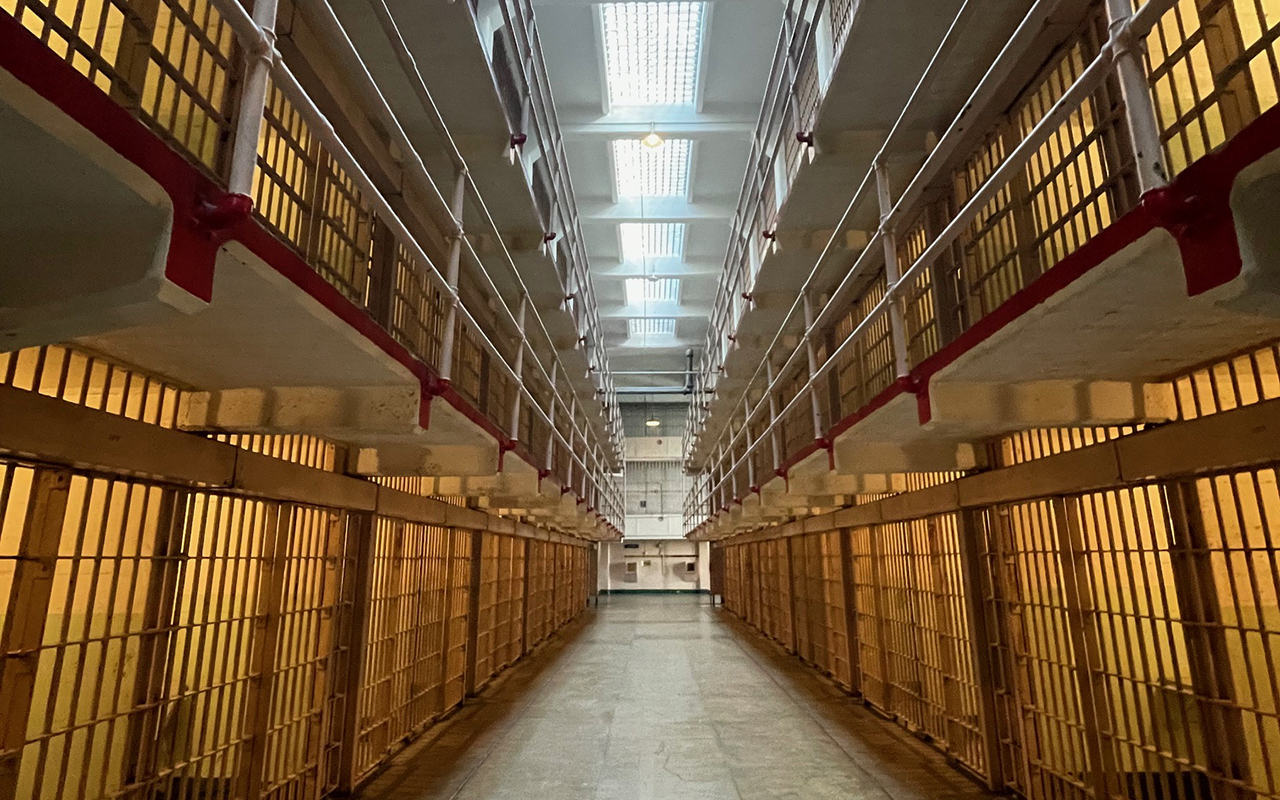 Credit: Marnette Federis
Credit: Marnette Federis
I’ve got to start this list with the infamous cellhouse that every tourist is keen to visit when they arrive on the island.
The reinforced concrete, three-story building you see today was created in 1912, built on top of what used to be the island’s fort. Construction on the building began in 1908 once the island became an official military prison. During that time, the facility saw anywhere between 200 to 600 prisoners.
When the prison was transferred to the Department of Justice, the building underwent remodeling to prepare for the incoming federal prisoners. The cellhouse consists of an administration wing, four cell blocks, a hospital wing and a dining room area. A recreation yard is attached to the cellhouse.
Pro tip: The best way to learn more and explore the cellhouse is through the park’s audio tour, including with your ticket to the island.
2. Guard Tower

Guard towers and catwalks were built in the 1930s once Alcatraz started operating as a federal prison. One tower overlooking the island’s dock still stands today and is one of the first structures you’ll see when arriving at Alcatraz.
Fun fact: The dock guard tower was repaired and repainted in 2013 as part of a larger restoration effort.
3. The barracks aka Building 64

Credit: Gary Bembridge / CC BY 2.0
Building 64 is the first notable building you’ll see after getting off the ferry and setting foot on Alcatraz. One of the oldest structures on the island, the building has lived through the many versions of Alcatraz — from fortress to military prison and federal prison to national park. The original bombproof structure on the ground floor housed cannons and soldiers when Alcatraz was fortified to protect the San Francisco Bay.
The structure still features large square windows meant to be cannon ports. Barracks were built in the 1860s on top of the fortified structure when the island became a military prison to house the guards. In 1905, the open barracks were enclosed and divided into apartments, creating a three-story apartment building that would house correctional officers and their family members.
Today, the bookstore, theater and an exhibit space occupy the bottom part of the building.
4. Sally Port and Guardhouse

Credit: Cifraser1 / CC BY 2.0
Go past Building 64, and you’ll walk through what used to be the Sally Port and Guardhouse complex. Built in 1857, this is one of the oldest structures on the island.
It was meant to defend the fort atop the hill with a moat, gun ports, and artillery. But this defensive equipment was never used. The Guardhouse later served as a prison for Army soldiers accused of various crimes. Other military prisoners were also held there until officials expanded prison facilities at the island’s summit. The Guardhouse structure was also used as a library, theater, chapel, and schoolhouse.
5. Officer’s Club
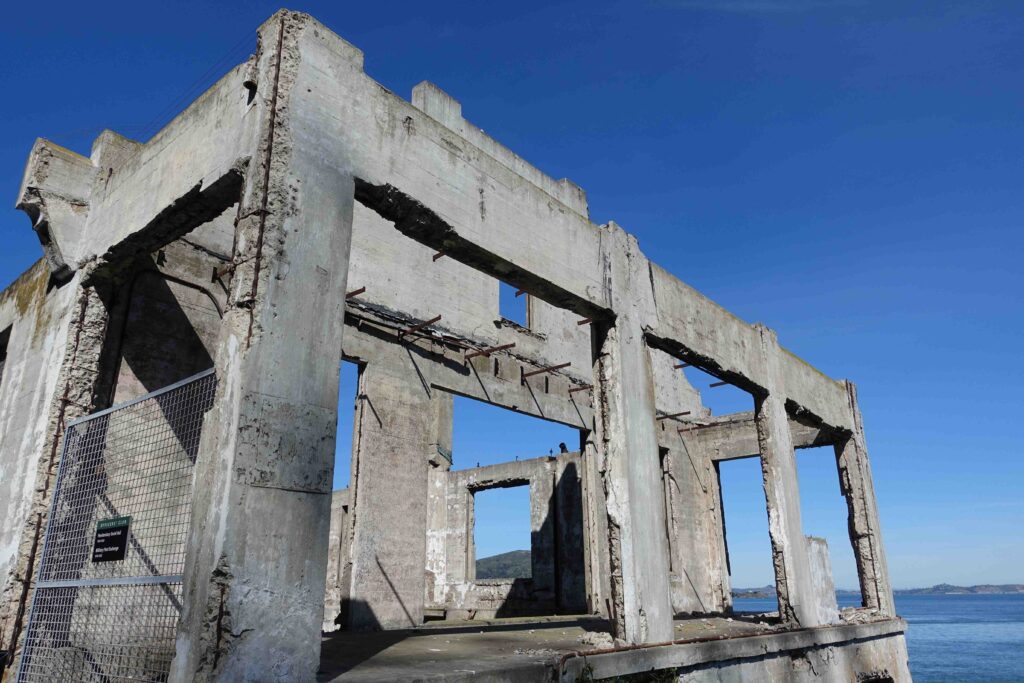
One of the picturesque ruins you’ll find on Alcatraz is the Officer’s Club or Social Hall.
In the early 1900s, when Alcatraz was a military prison, the building was used as a post exchange, which included a general store, cafeteria, barbershop, and post office.
When the military transferred the island to the Department of Justice, the building became known as the “Social Hall” or recreation center. It was the social center for staff and their family living on the island and served as a venue for events, meetings, celebrations, and holiday parties.
Activities inside the building, including pool tables and bowling alley lanes, made it a favorite hangout spot for teens. For safety reasons, the Social Hall only opened at night — when prisoners were locked in their cells and accounted for.
Why is it in ruins now? During the Native American occupation in 1970, the building caught fire, leaving only a burned-out shell.
6. Warden’s House

Credit: Adam Kliczek / CC-BY-SA-3.0
Built in the 1920s, the Warden’s House is a massive structure right next to the infamous cellhouse. It’s not so much a house but a mansion.
Official National Park Service information says the building featured three floors and 15 rooms, but other sources have stated that the building once had as many as 17 rooms.
This former home of the commandant of the military prison, which boasts a phenomenal view of the San Francisco skyline, later housed four wardens who oversaw the federal prison. The house burned during the Native American occupation between 1969 and 1971, and park officials have had to do extensive work to preserve what’s left of the historic structure. If you’re visiting during spring, you can enjoy beautiful blooms in the gardens next to the Warden’s House.
7. Model Industries Building and New Industries Building
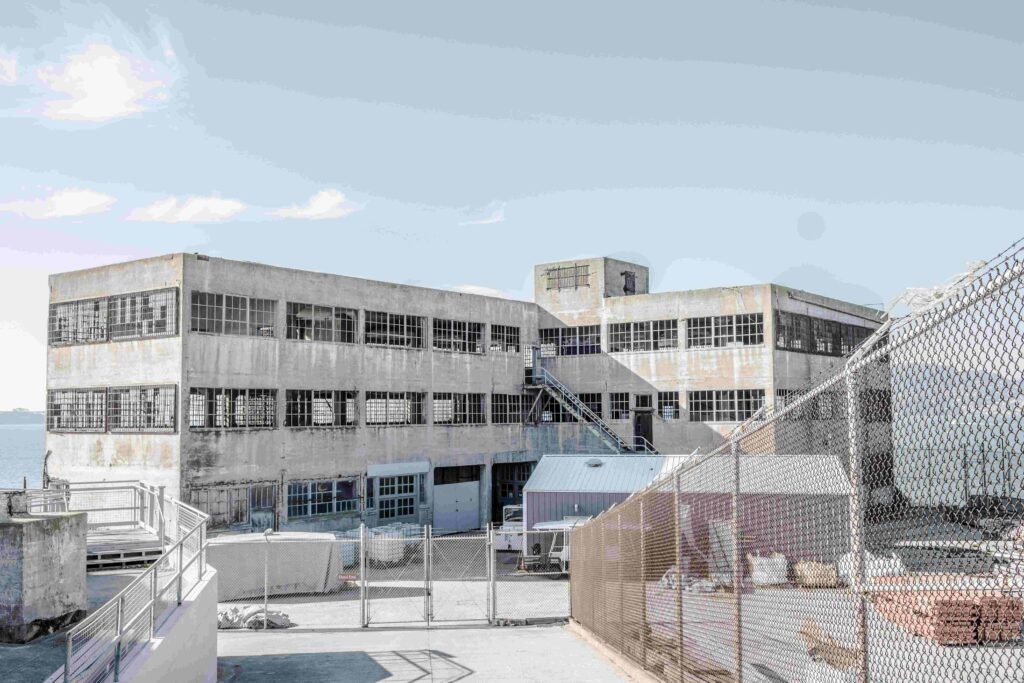
Both of these buildings were used for prison retraining and development. The Model Industries Building was built first in 1921. The three-story building at the edge of the island’s cliff featured a blacksmith shop, plumber’s shop, band practice room, a vocational school, and more for the military prisoners. It was also used as a laundry for military personnel stationed across the Bay.
When the Bureau of Prisons took over, officials were unhappy with the building’s layout and lack of security. So they built the New Industries Building in 1939 and moved the laundry operations there.
Incarcerated men on Alcatraz worked inside the New Industries Building, manufacturing mats from old rubber tires, crafting furniture, and producing brushes, clothing, and gloves. During World War II, the men made cargo nets for the U.S. Navy and repaired steel flotation buoys for anti-submarine nets in the Bay.
The New Industries Building is used as an exhibit space today and is open for a few hours a day (check the dock schedule once you land) for more information.
8. Powerplant and Quartermaster Warehouse
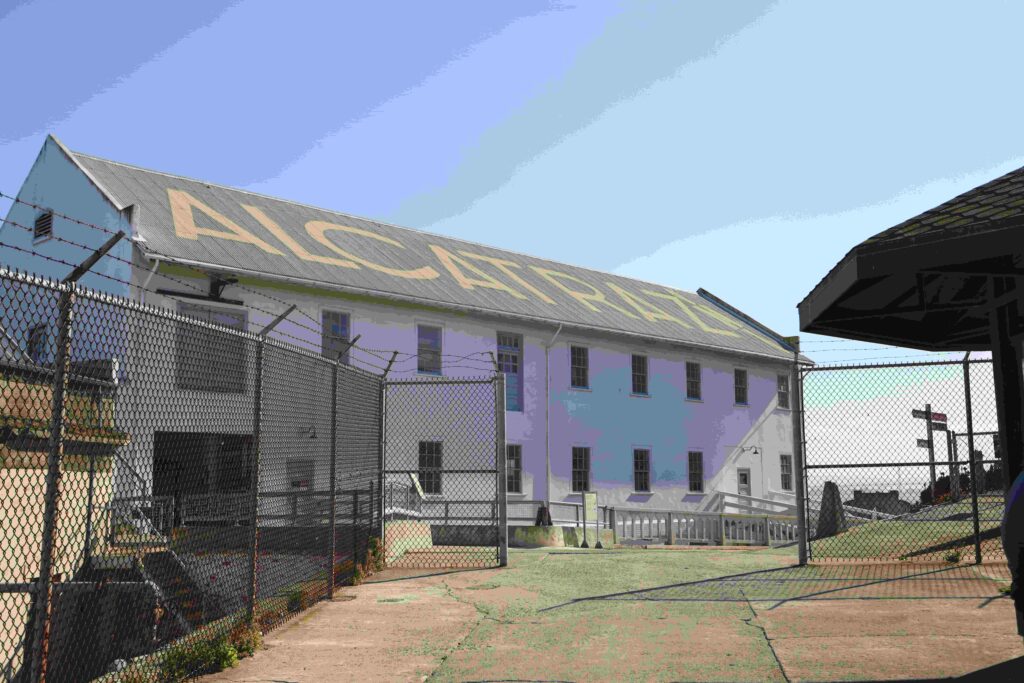
These two buildings were essential to the function of Alcatraz as a military prison and federal penitentiary. Because of this, prisoners were mainly kept out of this area — unlike other facilities, where prisoners were often working.
- The Power Plant, built in 1912, provided electricity and kept water pumps running throughout the island’s facilities.
- The Quartermaster Warehouse, built in 1921, featured the office of the Post Quartermaster, the person responsible for the island’s maintenance and supplies.
The four-level warehouse also served as storage and, during the military prison years, was the location of the commissary. When Alcatraz became a federal prison, the warehouse maintained many of the same functions (minus the commissary) and became an office, storage and workshop space (for equipment repairs).
You’ll notice “ALCATRAZ” painted on the roof with an arrow pointing north. This was a helpful point of reference for aviators back in the day as they navigated the bay area.
The building is the site of graffiti and paintings from the American Indian Movement occupation from 1969 to 1971. When the warehouse underwent renovations and restoration in 2016-2017, the workers went to great lengths to preserve the paintings. These buildings are not open to the public, but park officials encourage visitors to look at the exterior walls and the paintings.
Fun fact: The side of the building facing the water is also an area where protected birds nest.
9. Water tower
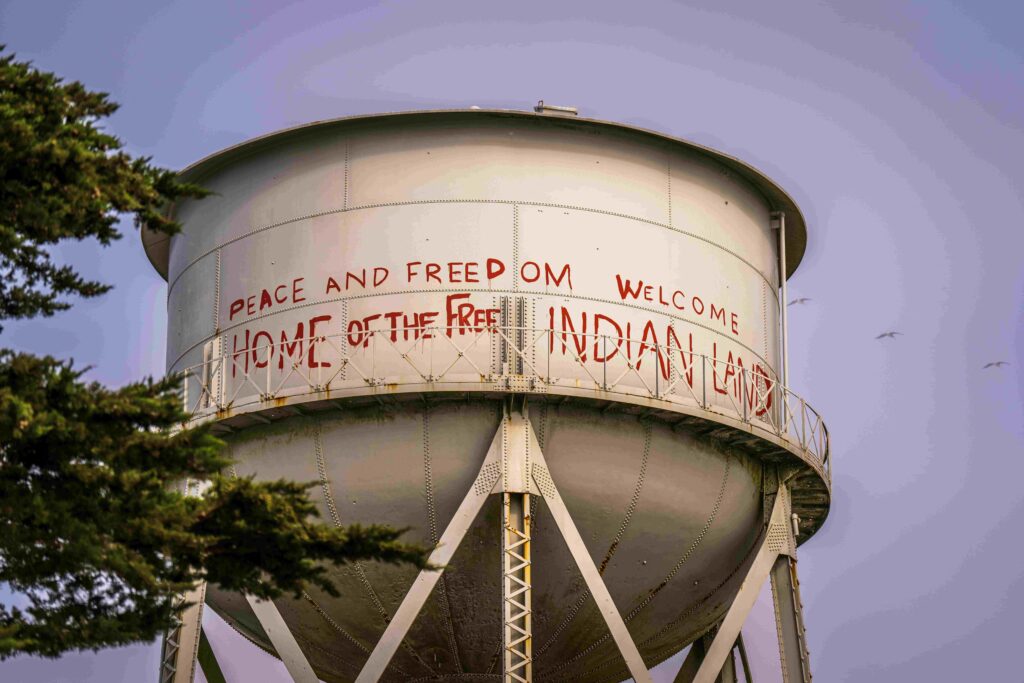
One of the tallest structures on the island, the water tower is one of the more noticeable features when you’re riding to the island from the ferry. Built in 1940, the tower stored the island’s only water source, used for the prisoners’ drinking water and laundry operations and as water reserves in case of fires.
Activists painted political messages on the tower during the Native American occupation of Alcatraz from 1969 through 1971. When the water tower underwent restoration from 2011 to 2012, park officials invited family members of Richard Oakes, a leader and key figure of the occupation, to recreate the writings.
10. Lighthouse

The island’s original lighthouse was built in 1854 as part of the citadel complex on the island’s summit. It was the first lighthouse on the West Coast and helped vessels navigate the bay. After the construction of the cellhouse, a newer, 95-foot-tall lighthouse structure was built in 1909. That newer lighthouse became automated with a modern beacon in 1963, the same year the federal prison closed.
11. Military chapel
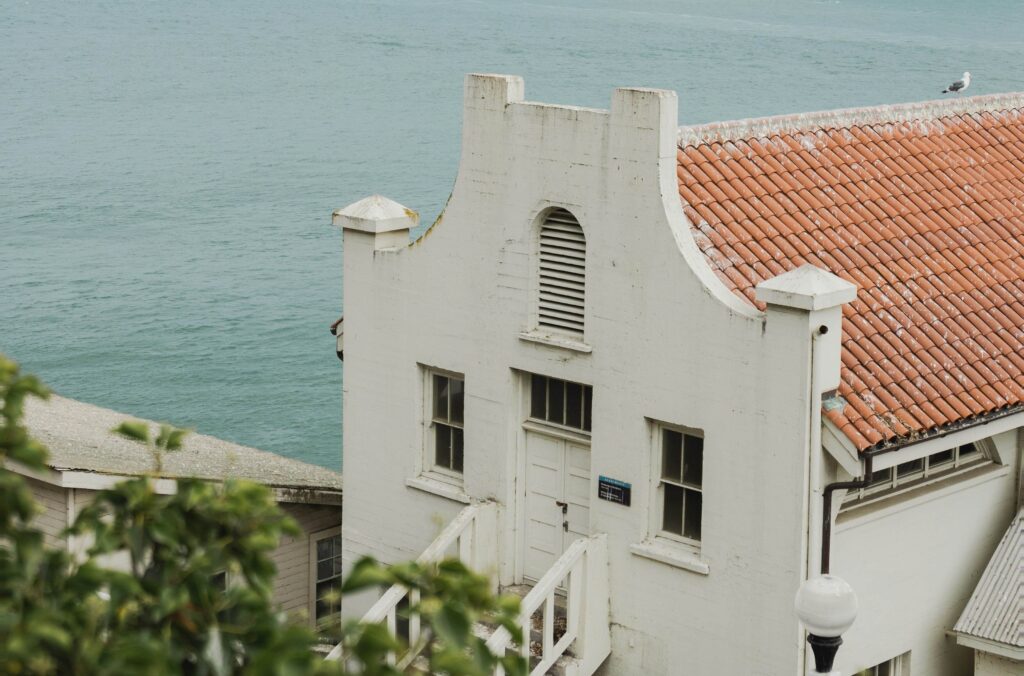
Built in the 1920s, the military chapel was an additional building constructed atop the Guardhouse. You’ll notice its mission-revival architectural style while walking up the road to the cellhouse.
The building served as living quarters for military personnel and their families as well as a school and chapel. When Alcatraz became a federal prison, the whole building became living quarters for prison staff, especially those who were unmarried and didn’t have families. It eventually became known as the “Bachelor’s Quarters” for this very reason.
Explore Alcatraz

There’s so much more to explore on Alcatraz, from the gardens to the birds to the buildings to the exhibits. The only way to experience it for yourself is to take a tour!
Join any of our guided tours and you’ll get to take a cruise at the end to this historic and fascinating island. We can’t wait to show you the best of the San Francisco Bay!